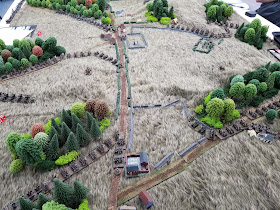My second game of the convention was a demo game of "Et Sans Resultats!", a grand tactical set of rules by The Wargaming Company.
I had heard a lot about ESR from various websites, blogs and podcasts, and had been looking to get a game of it myself. Luckily, the Wargaming Company offers plenty of demo games during conventions.
This scenario was a generic battle set during the War of the Sixth Coalition in 1813. Two French divisions were set against an allied force of Prussians and Russians, each with a division of their own. There was a good mix of infantry, artillery, and cavalry. I took control of the Russians.
It should be pretty obvious that, whatever I may think of the rules themselves, ESR makes for a fantastic looking game, especially in 10mm. It really did feel like I was commanding an army, especially since a good chunk of the game was spent maneuvering my brigades into position.
While I had seen from other reviews that ESR had something of a novel approach to army command, I didn't have an appreciation for it until I had a chance to play the game myself.
Instead of just moving units around the table, I had to choose an objective for my overall command (it ended up being the crossroads at the bottom of the above picture. My Prussian counterpart choose the crossroads at the top). From here, my formations (brigades) could be given orders on how to interact with the objective - Move to it, Attack towards it, Defend it, Support it, etc. This made for an... interesting interaction with the game itself.
For example, my infantry brigades had been ordered to move towards the crossroads. However, they could not then advance beyond the crossroads to attack the French moving in front of them. I had to sit still, unless I wanted to change my overall command's objective, which would then affect how each of the other formations in my army would have to move.
I did have to keep in mind that, at the scale the game was using, each inch on the tabletop represented 150 yards. So the French troops that were "only" 6-7 inches away were actually 900-1050 yards distant!
Also interesting was the difference between "ployed" and "deployed" units. Ployed units can be seen in column, moving towards the objective at a faster rate. Deployed units have fallen out of column and move slower. Each turn, a commander can usually move 2-5 units from Ployed to Deployed. And it's important to make sure this transition happens before contacting with the enemy, as Ployed units aren't counted when comparing against a units overall Fatigue. A brigade with only two or three Deployed units is extremely like to break and run if they get into combat.
Over on the other side of the table, the Prussians were quickly being swarmed by two columns of French troops.
Both sides were quickly deploying as many of their units as they could. The Prussian cavalry moved in to attack (there's a whole thing in the rules were certain units can change their Order status under certain conditions), but were beaten back by the French infantry.
I should note that each of these stands of infantry, cavalry or artillery represent a brigade, squadron, or battery, respectively. ESR operates at a level where units don't have to worry about whether their troops are in line, square or column, although being attack in the rear edge of the stand is still problematic.
With one of my infantry brigades on defense, I ordered my second brigade to do the same as I deployed as many infantry battalions as possibly. My army commander looked on from the hilltop as my cavalry brigade readied itself.
The French pushed in, driving back my cavalry and moving against both my infantry brigades.
Over on the left, the French and Prussians were fully engaged, with waves of infantry impacting.
At the 150 yard scale, combat from 0" to 6" is considering skirmishing and artillery fire, and its not until units come into combat that "combat" occurs (which is what most other, smaller scope games would fight out in full).
For my Russians, it wasn't looking good. The French had a better overall Combat Rating for most of their battalions, my cavalry was in full retreat, leaving a massive gape in my center, and the French had set up their artillery to pound my left flank.
It also didn't seem to be going well for the Prussians, who had been caught off-guard with the speed of the French advanced on their positions.
By then I had to leave for the drive back home, so I thanked the guys running the game and packed up.
Overall, my experience with ESR was mixed. I should admit that it probably wasn't enhanced by the migraine I had, much like the game of Chain of Command I had played at a previous HMGS convention. But at the same time, there were certain things about ESR that just felt off.
For example, compare the command and movement of troops to skirmishing, artillery, and combat. There are plenty of modifiers and well laid out charts to work out combats between units. Moving troops, on the other hands, feels far too... soft, I suppose. I wasn't sure if it was because I was a first time player, but it seemed odd that I had to pick a single geographic point to order my troops toward, while it seemed like the French moving against me had far freer movement to pick and choose where they wanted to go. Whether or not this was a misunderstanding on my part or something that wasn't fully explained, I didn't think to clear up.
I did end up getting the rulebook, so at the very least I can add that to my reference collection

































